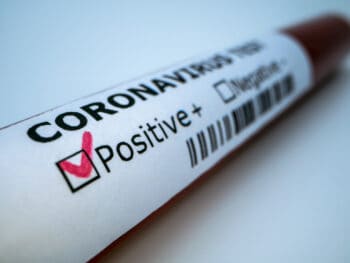How Would You Decide: Ulcerous Ankle Positional Risk?
Here’s what Tom Robinson, J.D., writer for Lexis Nexis Workers Comp Law Center reports.
District of Columbia Anesthesiologist’s Injuries From Employer’s Treatment to Her Injured Ankle Did Not Arise Out of and in the Course of Employment; Medical Malpractice Action Against Her Employer Can Proceed
Here’s What Happened
Bentt was employed as a fellow in pain management in the Department of Anesthesiology at the Georgetown University Hospital. One evening, while attending a banquet on her own time, she experienced some “difficulty” in her left lower ankle while wearing tight shoes. A few days later, while at work, she noticed she was having new discomfort in the ankle. Several colleagues, including her supervisor, noticed that she was noticeably limping throughout the workday.
At her supervisor’s suggestion, the supervisor administered a nerve block to Bentt’s left ankle area. When the pain returned the following day, the supervisor again administered a nerve block to the affected area. Bentt received one or more injections to the ankle thereafter. The skin in injection area because ulcerous and Bentt had to have surgery on the ankle.
Bentt filed a medical malpractice action against various defendants, including her employer. The employer contended the tort action was barred by the exclusive remedy provisions of the D.C. Workers’ Compensation Act. The Superior Court stayed the civil matter in order to permit the Department of Employment Services (“DOES”) to determine whether it had jurisdiction over the matter.
Bentt filed a claim with DOES, seeking a denial of benefits in order to pursue her tort action. The hearing examiner determined that Bentt did not sustain an injury arising out of and in the course of her employment because the conditions of her employment did not play a role in her original left foot and ankle conditions.
The Court of Appeals reversed [830 A.2d 865 (D.C. 2003)(“Bentt I“)], observing that the court had adopted the so-called “positional risk” test, that under the test “an injury could be said to arise out of the employment so long as it would not have happened but for the fact that conditions and obligations of the employment placed claimant in the position where she was injured.” [Bentt I at 872], and that the matter should be remanded to the Agency to allow a hearing examiner to address the causal significance of the injections-something the examiner did not do originally-and make appropriate findings of fact and conclusions of law.
Parenthetically, the court in Bentt I affirmed the finding that Bentt’s original tendinitis did not constitute an accidental injury under the Act.
On remand, an administrative law judge came to a conclusion that, according to the Court of Appeals, was not anticipated: that the injections did not arise out of Bentt’s employment. As the ALJ explained, there was no work-related event, activity, or requirement in the regular performance of Bentt’s employment that would have exposed her to receiving nerve block injections. The ALJ also found that nothing in the record supported the conclusion that by walking rounds, Bentt was exposed to the potential of receiving nerve block injections or the resulting complications she had from those injections. The Board reversed, indicating that it felt constrained by the Court of Appeals opinion in Bentt I, that had the ALJ properly applied the positional risk standard, as required by the Court of Appeals, the result would have been that the injection administered by Bentt’s supervisor would be classified as a compensable injury.
Importantly, the ALJ concluded that Bentt’s claim was compensable because (1) Bentt “was within the boundaries of time and space created by her employment at [the] time she received the injections”; and (2) “the injections arose directly from her limping and obvious discomfort as she performed her work.” This time the Board affirmed. The Board reasoned that but for Bentt’s employment with the hospital, “she would not have obtained the injurious injections.” The Board also stated, without citing any evidence in the record, that the injections “were presumably given at least in part to enhance [Bentt’s] ability to continue to perform [her work] duties.” Bentt then petitioned the Court of Appeals to review the Board’s decision.
Here’s How the Court Ruled
In Bentt v. District of Columbia Dep’t of Employment Servs., 2009 D.C App. LEXIS 451 (Sept. 10, 2009), the District of Columbia Court of Appeals, in a split decision, reversed and remanded the case yet again to the ALJ, this time with instructions to deny Bentt’s claim (no doubt pleasing Bentt, since her tort claim against the employer can now proceed). At the outset, the majority observed that “the linchpin” of the Court’s decision in Bentt I had been the conclusion that the injections could have been a separate injury (provided, of course, that the injections arose out of and in the course of Bentt’s employment). According to the majority, had the Court concluded that the injections were “treatment” rather than an “injury,” there would have been no occasion to remand. Thus, the Court’s earlier holding that the injections could be considered a separate injury was the law of the case and would not be revisited.
As to whether Bentt’s injury arose out of the employment, the majority again observed that the District of Columbia utilized the positional risk doctrine [citing Clark v. District of Columbia Dep’t of Employment Servs., 743 A.2d 722, 727 (D.C. 2000)]. The majority indicated that following remand, the ADJ had determined that it was not the “conditions and obligations of the employment,” [Clark, 743 A.2d at 727] but rather circumstances personal to Bentt that placed Bentt in the position where she was hurt. The majority stated that because the ALJ’s decision on remand was supported by substantial evidence and consistent with applicable law, the Board had exceeded its permissible scope of review by reversing the order. The majority also stated that while it appreciated that the Board might have felt the Court’s earlier decision left the agency no discretion to reach a contrary conclusion, such a reading of Bentt I by the Board was wrong. If the Court’s intent in Bentt I had been to conclusively determine the question, the Court would have reversed, not remanded. Furthermore, the Board’s gratuitous statement that the injections “were presumably given at least in part” to help Bentt perform her duties was without basis; there was nothing in the record to support such a conclusion.
The majority added that even if Bentt’s injuries arose out of her employment, they were nevertheless not compensable under the Act because the injections did not arise in the course of her employment. The majority noted that there was little dispute that the injections took place at Bentt’s workplace during work hours. The question, therefore, was whether Bentt was doing something “reasonably incidental” to her employment when she received her injections. According to the majority, there was no evidence that when Bentt was laying face down receiving injections from her supervisor, she was “engaging in a reasonable and foreseeable activity that [was] reasonably related to or incidental to … her employment.” The majority specifically indicated it made no difference that both the employer and Bentt benefited from the injections. While that might sometimes be an important issue, it was not a determining one. The majority indicated further that nothing in the record indicated that receiving injections was a work-related risk.
Judge Kramer dissented, indicating in relevant part that the majority opinion was problematic in that it (1) disregarded the Court’s conclusion in Bentt I; (2) improperly concluded that Bentt suffered only a “personal” injury; and (3) failed to give the appropriate deference to the agency’s decision. According to Judge Kramer, the Board’s decision that Bentt’s injury arose out of and in the course of employment was in accordance with law and supported by substantial evidence in the record. The judge added that the majority’s conclusion that Bentt’s injury was personal to her and did not arise out of and in the course of her employment was markedly inconsistent with Bentt I, that while Bentt I did not dictate the conclusion that Bentt’s injury arose out of and in the course of employment, it recognized that the record at that time suggested that conclusion. The Court had not so ruled conclusively, said Kramer, because the Court did not have before it the complete depositions of one two witnesses (one of them Bentt, herself), but the Court’s language in Bentt I clearly indicated that unless some new and unexpected evidence emerged on remand, the Workers’ Compensation Act covered Bentt’s injections and resulting injury. Kramer stressed that no such evidence emerged. After the ALJ and the Board addressed the causal significance of the injections and made appropriate findings of fact and conclusions of law, as had been ordered, both concluded that Bentt’s injury did arise out of and in the course of employment. Kramer indicated that to now hold that the Board was erroneous in reaching this conclusion sent a confusing and contradictory message. (workersxzcompxzkit)
Author’s Note: It seems difficult to square the majority’s statement that the District of Columbia follows the positional risk rule with its decision in Bentt II. As observed in Judge Kramer’s dissent, citing Grayson v. District of Columbia Dep’t of Employment Servs., 516 A.2d 909, 911 (D.C. 1986) (quoting Larson’s Workers’ Compensation Law §3.05), under the positional-risk standard, “[a]n injury arises out of the employment if it would not have occurred but for the fact that conditions and obligations of the employment placed claimant in a position where he was injured.” [Emphasis in original] As the Court of Appeals had earlier indicated in Clark (noted above), the positional-risk standard “obviates any requirement of employer fault or of a causal relationship between the nature of the employment and the risk of injury. Nor need the employee be engaged at the time of the injury in activity of benefit to the employer.”
I have no real quarrel with the majority’s conclusion here: that the injection injuries did not arise out of and in the course of the employment. The exclusive remedy defense would likely fail in the vast majority of states, but under a different theory: the “dual persona” doctrine, which holds generally that an employer may become a third person, vulnerable to tort suit by an employee, if it possesses a second persona so completely independent from and unrelated to its status as employer that by established standards the law recognizes that persona as a separate legal person. One relatively common second persona occurs when the employer treats the employee as a private patient [see Larson’s Workers’ Compensation Law, § 113.01, 113.08]. As an aside, perhaps the majority felt constrained by the Court’s earlier holding in Bentt that the injections were not treatment, although in all candor, how the Court can categorize the injections as anything otherwise is beyond me. But back to the dual persona doctrine, here Bentt’s original injury was not work-related. Were it not for the positional risk rule, the Board could originally have found that Bentt received medical treatment in a fashion similar to that afforded members of the general public, triggering the dual persona rule.
The positional risk rule will not permit such a course, however, since it looks primarily to the time and place of the injury, not to other circumstances. It is the District’s so-called adherence to the positional risk rule that requires such gyrations in logic by the majority, as it must give at least lip service to the positional risk doctrine, a doctrine followed by a small minority of jurisdictions. It remains to be seen whether the majority’s opinion does significant damage to the positional risk rule within the jurisdiction. The majority appears to be blowing hot and cold in its statement that the jurisdiction follows the doctrine on the one hand and on the other that in order for an injury to be deemed within the course and scope of the employment, the injured employee must be engaged in a “reasonable and foreseeable activity that [was] reasonably related to or incidental to … [the] employment.” The majority’s is no simple “but for” test normally associated with the positional risk rule.]
See generally Larson’s Workers’ Compensation Law, § 3.05, 113.01, 113.08.
Tom Robinson, J.D. is the primary upkeep writer for Larson’s Workers’ Compensation Law (LexisNexis) and Larson’s Workers’ Compensation, Desk Edition (LexisNexis). He is a contributing writer for California Compensation Cases (LexisNexis) and Benefits Review Board – Longshore Reporter(LexisNexis), and is a contributing author to New York Workers’ Compensation Handbook (LexisNexis). Robinson is an authority in the area of workers’ compensation and we are happy to have him as a Guest Contributor to Workers’ Comp Kit Blog. Tom can be reached at: compwriter@gmail.com.
http://law.lexisnexis.com/practiceareas/Workers-Compensation
Try Our FREE
WC Best Practices IQ Test: http://www.workerscompkit.com/intro/
WC Books: http://www.reduceyourworkerscomp.com/workers-comp-books-manuals.php
WC Calculator: www.reduceyourworkerscomp.com/calculator.php
Return to Work in Unionized Companies
http://reduceyourworkerscomp.com//Return-to-Work-Programs-Unionized-Companies.php
©2008 Amaxx Risk Solutions, Inc. All rights reserved under International Copyright Law. If you would like permission to reprint this material, contact Info@WorkersCompKit.com













